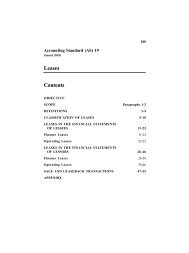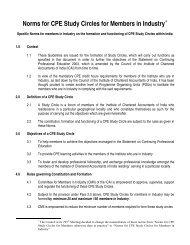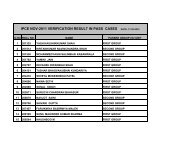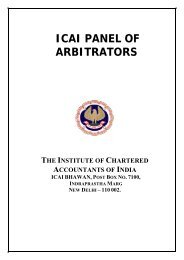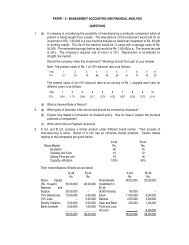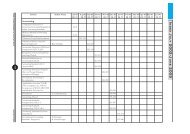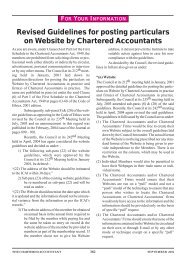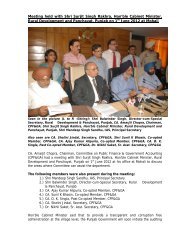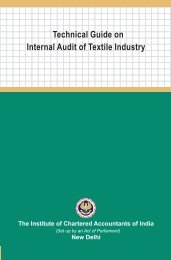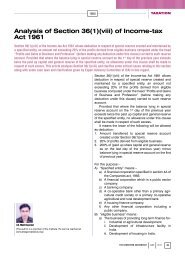The Chartered Accountant
The Chartered Accountant
The Chartered Accountant
Create successful ePaper yourself
Turn your PDF publications into a flip-book with our unique Google optimized e-Paper software.
Introduction<br />
1. <strong>The</strong> purpose of this Standard on<br />
Internal Audit is to establish standards<br />
and provide guidance on the<br />
procedures to be followed by the internal<br />
auditor in evaluating the system<br />
of internal control in an entity<br />
and for communicating weaknesses<br />
therein to those charged with governance.<br />
Nature, Purpose and Types<br />
of Internal Controls<br />
2. Internal controls are a system consisting<br />
of specific policies and procedures<br />
designed to provide management<br />
with reasonable assurance that<br />
the goals and objectives it believes<br />
important to the entity will be met.<br />
“Internal Control System” means all<br />
the policies and procedures (internal<br />
controls) adopted by the management<br />
of an entity to assist in achieving<br />
management’s objective of ensuring,<br />
as far as practicable, the orderly<br />
and efficient conduct of its business,<br />
including adherence to management<br />
policies, the safeguarding of<br />
assets, the prevention and detection<br />
of fraud and error, the accuracy and<br />
completeness of the accounting records,<br />
and the timely preparation of<br />
reliable financial information. <strong>The</strong><br />
DECEMBER 2008 1112 THE CHARTERED ACCOUNTANT<br />
EXPOSURE DRAFTS<br />
EXPOSURE DRAFT<br />
Standard on Internal Audit (SIA)<br />
INTERNAL CONTROL EVALUATION<br />
<strong>The</strong> Internal Audit Standards Board (hitherto known as the Committee on Internal Audit), of the Institute of<br />
<strong>Chartered</strong> <strong>Accountant</strong>s of India invites comments on the Exposure Draft of the Standard on Internal Audit (SIA),<br />
Internal control Evaluation. Comments are most helpful if they indicate the specific paragraph(s) to which they<br />
relate, contain a clear rationale and, where applicable, provide a suggestion for alternative wording.<br />
Comments should be submitted in writing to:<br />
Secretary, Internal Audit Standards Board,<br />
<strong>The</strong> Institute of <strong>Chartered</strong> <strong>Accountant</strong>s of India,<br />
ICAI Bhawan,<br />
C-1, Sector-1, Noida – 201 301<br />
<strong>The</strong> last date for receiving comments is January 12, 2009.<br />
Comments can also be emailed at cia@icai.in.<br />
internal audit function constitutes a<br />
separate component of internal control<br />
with the objective of determining<br />
whether other internal controls<br />
are well designed and properly operated.<br />
Internal control system consists<br />
of interrelated components as follows:<br />
l Control (or Operating)<br />
Environment<br />
l Risk Assessment<br />
l Control Objective Setting<br />
l Event Identification<br />
l Control Activities<br />
l Information and Communication<br />
l Monitoring<br />
l Risk Response<br />
3. <strong>The</strong> system of internal control<br />
must be under continuing supervision<br />
by management to determine<br />
that it is functioning as prescribed<br />
and is modified, as appropriate, for<br />
changes in conditions. <strong>The</strong> internal<br />
control system extends beyond those<br />
matters which relate directly to the<br />
functions of the accounting system<br />
and comprises:<br />
a. “control environment” means<br />
the overall attitude, awareness<br />
and actions of directors and<br />
management regarding the internal<br />
control system and its<br />
importance in the entity. <strong>The</strong><br />
control environment has an<br />
effect on the effectiveness of<br />
the specific control procedures<br />
and provides the background<br />
against which other controls<br />
are operated. Factors reflected<br />
in the control environment include:<br />
m <strong>The</strong> entity’s organisational<br />
structure and methods of<br />
assigning authority and<br />
responsibility (including<br />
segregation of duties and<br />
supervisory functions).<br />
m <strong>The</strong> function of the board<br />
of directors and its committees<br />
in the case of a<br />
company or the corresponding<br />
governing body<br />
in case of any other entity.<br />
m Management’s philosophy<br />
and operating style.<br />
m Management’s control system<br />
including the internal<br />
audit function, personnel<br />
policies and procedures.



